Tacoma Narrows Bridge history - Bridge - The bridge machine since 1950
The bridge machine since 1950
Surviving earthquakes and lightning, and other special features of the Current Narrows Bridge.
What's here?
- How big is the bridge?
- "Span stats" - 1940 vs 1950
- Maintenance - Keeping the span sparkling
- The inspection of 2000
- Paint it "Narrows Green"
- Danger, earthquakes, and lightning
- Working hard to keep traffic moving
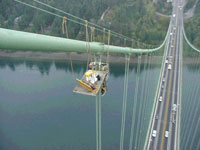
Workmen adjust bolts on a suspender cable band, nearly 300 feet above traffic WSDOT, 10-12-00, MVC-001S
How big is the bridge?
The towers are how tall?
The two towers of the current Tacoma Narrows Bridge rise 467 feet above the piers. How tall is that? By comparison, the Seattle Space Needle is 138 feet taller, measuring 605 feet high. The Statue of Liberty is only 305 feet high, or 162 feet shorter than the Bridge's towers.
The bridge is how long?
You could line up nearly 10 Seattle Space Needles end-to-end and match the length of the Narrows Bridge today. Or, lay down New York's great Empire State Building 4 times and you'd be really close. Or, try corralling 1,195 kids, say 7th graders with an average height of 5 feet, then lay them head-to-toe and they will stretch the length of the Narrows Bridge. Check out the TABLE below for other interesting comparisons.
Span stats - Current Narrows Bridge (1950) compared with other "structures"
| Name | Total Length or height | How many would fit on the Tacoma Narrows Bridge? (5,979 feet) |
|---|---|---|
| Space Needle, Seattle | 605 feet | 9.9 |
| Golden Gate Bridge, San Francisco | 6,450 feet | 0.9 |
| Empire State Building, New York | 1,453 feet | 4.1 |
| Statue of Liberty, New York | 305 feet | 19.6 |
| Eiffel Tower, France | 1,063 feet | 5.6 |
| Titanic | 885 feet | 6.7 |
| Average 7th grader | 5 feet | 1,195 |
The Bridge is How Wide?
60 feet between the main suspension cables. If you use the average 5-foot tall 7th Grader as a yardstick, you'll only need 12 of them head-to-toe.
"Span stats"
How Does the Current Narrows Bridge Compare with Galloping Gertie?
| Length | 1950 Bridge | 1940 Bridge |
|---|---|---|
| Total Structure Length | 5,979 feet | 5,939 feet |
| Suspension Bridge Section | 5,000 feet | 5,000 feet |
| Center Span | 2,800 feet | 2,800 feet |
| Shore Suspension Spans (2), each | 1,100 feet | 1,100 feet |
| East Approach and Anchorage | 365 feet | 345 feet |
| West Approach and Anchorage | 614 feet | 594 feet |
| Anchorages (shore anchors) | 1950 Bridge | 1940 Bridge |
|---|---|---|
| Weight of each anchorage | 66,000 tons | 52,500 tons |
| Concrete in each anchorage | 25,000 cu. yds. | 20,000 cu. yds. |
| West Anchorage (concrete anchor block and gallery) | 164 feet long |
169 feet long 70 feet wide 66 feet deep |
| East Anchorage (concrete anchor block and gallery), plus approach, administration buildings and toll house | 185 feet long | 173 feet long 70 feet 50 feet high |
| West Anchorage, construction | Woodworth & Co. | Woodworth & Cornell, Inc. $340,000 |
| East Anchorage, construction | Woodworth & Co. | Pacific Bridge Co. $500,000 |
| Piers | 1950 Bridge | 1940 Bridge |
|---|---|---|
| West Pier, total height | 215 feet | 198 feet |
| West Pier, depth of water | 120 feet | 120 feet |
| West Pier, penetration at bottom | 55 feet | 55 feet |
| East Pier, total height | 265 feet | 247 feet |
| East Pier, depth of water | 135 feet | 140 feet |
| East Pier, penetration at bottom | 90 feet | 105 feet |
| Area | 118 feet, 11 inches by 65 feet, 11 inches | 118 feet, 11 inches by 65 feet, 11 inches |
| Reinforced concrete in piers | 111,234 cu. yds. | 111,234 cu. yds. |
| Number of caisson anchors, east pier | 32 | 32 |
| Number of caisson anchors, west pier | 24 | 24 |
| Weight of each caisson anchor | 570 tons | 570 tons |
| Size of caisson anchors | 12 x 12 x 51 feet 6 inches in 900 foot diameter circle around caisson |
12 x 12 x 51 feet 6 inches in 900 foot diameter circle around caisson |
| Distance between piers | 2,700 feet | 2,700 feet |
| Distance to shore from east pier | 650 feet | 650 feet |
| Distance to shore from west pier | 1,030 feet | 1,030 feet |
| Cables | 1950 Bridge | 1940 Bridge |
|---|---|---|
| Diameter of Main Suspension Cable |
20.25 inches | 17.5 inches |
| Weight of Main Suspension Cable (each) |
5,441 tons | 3,817 tons |
| Weight Sustained by Cables | 18,160 tons | 11,250 tons |
| Number of No. 6 Wires in Each Cable |
8,705 | 6,308 |
| Sag ratio (elevation drop per foot) |
1:10 | 1:12 |
| Total Length of Wire | 104,094,390 feet, = 19,715 miles | 74,926,424 feet, = 14,191 miles |
| Towers | 1950 Bridge | 1940 Bridge |
|---|---|---|
| Height above water | 507 feet | 443 feet |
| Height above piers | 467 feet | 425 feet |
| Height above roadway | 307 feet | 230 feet |
| Weight of each tower | 2,675 tons | 1,927 tons |
| Roadway - Deck | 1950 Bridge | 1940 Bridge |
|---|---|---|
| Center Span Height Above Water | 187.5 feet | 195 feet |
| Weight of center span | 7,250 lb./ft | 5,700 lb./ft |
| Traffic lanes | 4 | 2 |
| Width of Roadway | 49 feet 10 inches | 26 feet |
| Width between Cables | 60 feet | 39 feet |
| Width of Sidewalks(2), each | 3 feet 10 inches | 5 feet |
| Number of girders and type | 2 Warren trusses | 2 plate girders |
| Depth of girders | 25 feet | 8 feet |
| Suspender cables | 32 foot intervals | 50 foot intervals |
| Thickness of roadway | 6-3/8 inch reinforced concrete | 5-1/4 inch reinforced concrete |
| Material | 1940 Bridge | Current |
|---|---|---|
| Structural Steel | 10,000 tons | 17,000 tons |
| Cable wire | 3,750 tons | 6,000 tons |
| Concrete in anchorages | 20,000 cu.yds | 25,000 cu.yds |
| Superstructure weight | 5,800 lbs/foot | 8,678 lbs/foot |
| Bridge | Width to Length (of Center Span) | Girder Depth to Length (of Center Span) |
|---|---|---|
| 1940 Narrows Bridge | 1:72 | 1:350 |
| Current Narrows Bridge | 1:46 | 1:112 |
| Golden Gate Bridge | 1:47 | 1:168 |
| George Washington Bridge | 1:33 | 1:120 |
| Bronx-Whitestone Bridge | 1:31 | 1:209 |
| Categories | 1940 Narrows Bridge (Galloping Gertie) | Current (1950) Narrows Bridge |
|---|---|---|
| Total Structure Length | 5,939 feet | 5,979 feet |
| Suspension Bridge Section | 5,000 feet | 5,000 feet |
| Center Span | 2,800 feet | 2,800 feet |
| Shore Suspension Spans (2) Each | 1,110 feet | 1,110 feet |
| Center Span Height Above Water | 195 feet | 187.5 feet |
| Width of Deck (cables, center-to-center) | 39 feet | 49 feet 10 inches |
| Width of Sidewalks (2), each | 5 feet | 3 feet 10 inches |
| Ratio, deck to center span | 1:72 | 1:56 |
| Anchorages: | ||
| Weight of Shore Anchors | 52,500 tons | 66,000 tons |
| East Approach and Anchorage | 345 feet | 365 feet |
| West Approach and Anchorage | 594 feet | 614 feet |
| Cables: | ||
| Diameter of Main Suspension Cable | 52,500 tons | 66,000 tons |
| Weight of Main Suspension Cable | 3,817 tons | 5,441 tons |
| Weight Sustained by Cable | 11,250 tons | 18,160 tons |
| Sag Ratio (elevation drop per foot) | 1:12 | 1:10 |
| Number of No. 6 Wires Each Cable | 6,308 | 8,705 |
| Total Length of Wire | 14,191 miles | 19,715 miles |
| Towers: | ||
| Height Above Water | 443 feet | 507 feet |
| Height Above Piers | 425 feet | 467 feet |
| Weight of Each Tower | 1,927 tons | 2,675 tons |
| Piers: | ||
| East Pier, Total Height | 247 feet | 265 feet |
| East Pier, Depth of Water | 140 feet | 140 feet |
| East Pier, Penetration at Bottom | 90 feet | 90 feet |
| West Pier, Total Height | 198 feet | 215 feet |
| West Pier, Dept of Water | 120 feet | 120 feet |
| West Pier, Penetration at Bottom | 55 feet | 55 feet |
| Area | 118 feet, 11 inches by 65 feet, 11 inches | 118 feet, 11 inches by 65 feet, 11 inches |
| Financing | 1940 Bridge | 1950 Bridge |
|---|---|---|
| P.W.A. grant (1938) R.F.C. loan – revenue bonds TOTAL | $2,894,958 $3,750,000 $6,644,958 | ----- |
| Bond Issue | $14,000,000 | |
| Final Cost | $6,618,138 | $14,011,384 |
| Tolls Removed | ------ | October 1965 |
| Time to Construct | 19 months | 29 Months |
| Tolls | car and driver 75 cents one way; $1.25 roundtrip | car and driver 50 cents one way; $1.00 roundtrip |
Maintenance - Keeping the Span Sparkling
From its opening in October 1950 until May 1965, the current Narrows Bridge was a toll facility. The Washington Toll Bridge Authority operated and maintained the Bridge, which collected over $19 million in tolls from motorists. Since then, the bridge has been the responsibility of the Washington Department of Highways, and its successor the Washington State Department of Transportation (WSDOT).
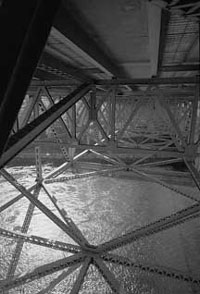
The maintenance crew often works under the roadway, where motorists never see them, and where it looks like this WSDOT
Today, the man in charge of keeping the bridge in top shape is Kip Wylie, Maintenance Supervisor at the Narrows Bridge. Wylie supervises a crew of five workers: three painters and two ironworkers. They stay busy with lots of replacement and repair work on the bridge, now over 50 years old. Painting season is roughly April 1 to November 1. During winter months, the crew works make sure the bridge is free of ice and snow so commuters have a safe and quick transit over the Narrows.
The cost is a very modest maintenance budget for the bridge--$1.7 million for the two-year budget period. That sounds like a lot, but it disappears fast. Now that you've studied the "Span Stats," you know just how big the bridge is. That mile-long structure with lots of moving parts takes a major maintenance job to keep it clean and in good working order. Good management by Wylie and his crew gets the most done for the least amount.
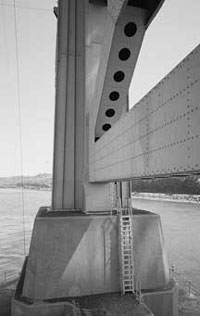
From bottom to top—painting and other maintenance takes the crew right to the base of the towers legs WSDOT
Where does the money go? Paint and street repairs are huge items. One of the biggest costs is repairing of the "expansion joints." There is a lot of movement where the East Deck and West Deck meet at the expansion joint. Each end of the bridge can move up to 16 inches, responding to the hottest summer weather (which expands the structure) and the coldest winter days (which contract the bridge deck). Often, there's little movement—not enough for motorists to notice. But, the expansion joints take a lot of punishment from traffic and from wind and temperature variations. And, they are over 50 years old, so they have become a constant repair item. When the speed limit was raised from 45 mph to 55 mph over the Narrows Bridge in the mid 1990s, the wear and tear on the expansion joints jumped significantly. And, so did the cost of repairs.
Inspections are a vital part of the maintenance work. The crew is always on the look out for signs of trouble. And, every Friday two of the crew takes do a general inspection of the towers, cables and anchorages. Once a month they look carefully at the main cables for paint cracks and other problems.
In 1983 an independent engineering consulting firm completed a comprehensive inspection of the bridge. They discovered several things. The suspender cables had stretched over the years. The towers' legs showed signs of increasing stress. And, the hydraulic dampers were not working well because the seals were deteriorating, causing loss of hydraulic fluid and pressure. Another independent consultant's inspection in 1991 used computer models and other sophisticated methods to evaluate the Current Narrows Bridge's health. Tests showed that the stretching of the suspender cables discovered in 1983 was actually not significant. Importantly, the 1991 inspection recommended a series of seismic tests to determine how well the Narrows Bridge could survive a major earthquake.
The inspection of 2000
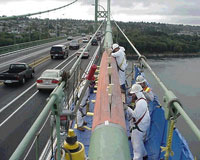
During the 2000 inspection, the main suspension cable was unwrapped and wedges driven to separate the wires, so the interior could be examined for rust, deterioration and moisture. WSDOT, 9-19-00 16
The inspection of 2000 marked a major milestone for the Tacoma Narrows Bridge, and for its maintenance crew. With plans moving forward for a brand new, second bridge (now under construction and to be completed in 2007), the WSDOT was required to show that the current span was in good shape, and that the new (2007) Narrows Bridge was not going to replace it. The inspection was performed by a private company that inspects bridges all over the country. At the end of the intensive evaluation, the verdict was impressive: "This bridge," they reported, "is one of the best in the nation for its maintenance and condition."
Paint It "Narrows Green"
Some call it "Gertie Green." Officially, it is "Narrows Green." It takes 6,000 gallons and 10 years of summertime work (roughly April 1 to November 1) for the crew to paint the Narrows Bridge.
Painting the bridge is dangerous work. The bridge crew follows safety requirements and procedures closely. Each worker wears a parachute harness—a full body harness—in the event of an accidental fall. You're "hooked off" at all times with 5,000 lb. test rope. The harness is designed so you can hang suspended for several hours while waiting for rescue. Back in the 1950s when the bridge was built, painters and maintenance men wore a simple belt.
Danger, earthquakes, and lightning
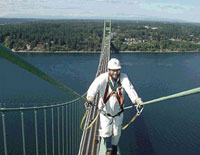
Walking the cable is one of the routine parts of the job - WSDOT, TNB drb2
Routine work is different on the Narrows Bridge, but it is still routine. There is picking up debris on the roadway (thanks to careless litterbugs). There is the chore of taking the 1-man elevator up a tower leg to inspect the airplane navigation beacon atop a tower. On rainy days, the crew inspects concrete on the anchorage. And, there's also lots of shop work, machining or cobbling pieces to repair equipment.
Working on a cable suspended 300 feet over cars and trucks as they whiz along the roadway is also mundane to the crew. Sometimes, they use the "spider," a 1-man platform with a waist-high cage that uses a motor-driven winch to take the maintenance crewman up or down to a repair site. Complacency with routine is a challenge. When you clip your safety harness to a line and dangle a hundred feet over the roadway or 500 feet over the water, it's important to pay attention.
Danger comes with the territory. Kip, Moergen, and the rest of the crew routinely work at great heights and in rough weather. Any given day, they don't really know what will come up. "That's the best part of the job," says maintenance lead Jon Moergen. "It can also be the worst."
One of the most memorable incidents for Kip Wylie happened during the winter of 1997. There was a terrible thunder storm. Rain was coming down sideways in sheets, driven by a high wind. The towers were steady. Then, Wylie got a call from the Washington State Patrol, telling him there was no navigation beacon on Tower 5 (East Tower). He went up to the tower top, battling the freezing rain and buffeting gusts. What he found was more surprising that scary. Lightning had struck the beacon. It popped the huge fixture's two bulbs, but otherwise there was no damage.
An ice storm that same winter took out power in the area for 3 days. The storm left a 2-inch thick sheet of ice covering the entire bridge. There was no power for the elevator, which meant one of the crew had to climb the 280 feet to the top of each tower using the hand ladder in a tower leg. Falling icicles prompted closure of the bridge for some 16 hours.
The "Nisqually Earthquake" that struck Puget Sound in February 2001 proved a little too exciting on the Narrows Bridge. Jon Moergen vividly recalls that day. The bridge swayed more than he'd ever seen it, first one way, then back the other. There was no damage when the shaking was all over, except for a bent housing where the cable passes into the east anchorage. Nonetheless, recalls Moergen, "It was scary." For a guy like him, who thinks nothing of walking up the main cable or dangling hundreds of feet over the chilly tides of the Narrows, that's saying a lot.
Several big windstorms have blasted the Narrows Bridge over the last 5 decades. One storm hit the bridge with winds of 75 miles per hour. Kip Wylie recalls a day when gusts up near 100 miles an hour slammed the span. A few times officials have closed the bridge to avoid having cars blown into the oncoming traffic lanes. But, not once since 1950 has the current Tacoma Narrows Bridge rippled, waved, bounced, or galloped.

Kip Wylie straddles the cable while positioning the cable compactor. WSDOT, 9-21-00 9
Working hard to keep traffic moving
Keeping the traffic moving is a top priority when repairs are needed. Most commuters seldom see or notice the maintenance crew's work. Routine repairs are scheduled for times when there is the least traffic. That means the late night and early morning hours on the weekends. Sometimes, non-routine events come along.Accidents happen all the time at the Tacoma Narrows Bridge—not just traffic fender benders, but accidents to the bridge.
For example, a few years ago, a truck hauling a submarine part to a U. S. Navy installation on the Peninsula tried to squeeze into one lane with its oversize load. The result was five long holes in the deck's pavement and a dent in one of the towers. Barges or boats run into the piers too often. Not long ago, a barge hauling a 220-foot tall crane struck the bridge's center span, causing some structural damage. Within recent months, large vehicles have ripped into various parts of the structure, including a hit on the main cable that tore off part of the wrapping wire.
Even emergency repairs are scheduled to minimize traffic disruptions. The crew works in the middle of the night and in all kinds of weather. One recent incident had the crew working all night long in a howling wind and rainstorm.
We don't notice, and that's how it's supposed to be. Repairing damage to the Tacoma Narrows Bridge is part of the work of the maintenance crew. But, it's one of the least seen, most overlooked, and least appreciated jobs they perform.